Barragens subterrâneas para armazenamento de águas subterrâneas em regiões semi-áridas do Nordeste do Brasil
Subsurface dams
Voltar
Download the practice
People in charge of the innovative practice :
Não conhecido
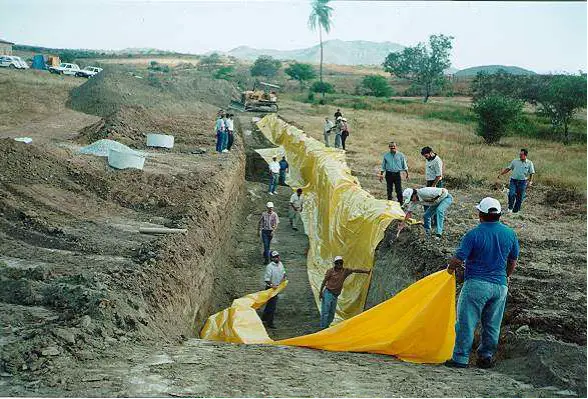
In Cirilo, Costa (1999)
The drought of 1990 decade has led to the development of subsurface (or underground) dams, with the aim of storing and providing water to supply small villages or communities and to agricultural activities while being able to fix people in these arid regions and avoiding their migration into the main cities. Such dams have the advantages of being able to store larger volumes of water than the natural alluvium aquifers underlain by crystalline basement rocks, and of being less susceptible to evaporative losses as the water is stored underground.
Detailed explanation
General description
This description is adapted from Shubo et al. (2020), considering also inputs from Costa (2004).
An underground dam allows rainwater to be stored under riverbeds during the rainy season, making it available for the dry season. Although simple, its construction must comply with some technical requirements regarding its location: the alluvium must be predominantly sandy; the slope must be as flat as possible; the depth of the impermeable layer must be greater than 1.5 m below the riverbed; the construction site must be at the narrowest part of the riverbed; the river basin head, where there is less water, should be avoided; and the recharge area upstream the dam should be of at least 1 km of alluvium material. Regarding water quality, low salinity rates are essential to make its implementation feasible and this should be addressed before building the dam.
The core idea of its operation is to restrict the flow of the alluvial aquifer by building an impermeable transverse septum, thus raising the level of the upstream water table. In Brazil, there are two types of underground dams suitable to local features: the submerged type, also known as the Costa & Melo type and the submersible type. Both of them make use of a buried impermeable septum to restrict the underground flow and are equipped with an Amazon type well to allow the use of the accumulated water in the saturated zone. To build the septum, a trench is dug down to the impervious layer. Then, a plastic blanket is placed over the septum and covered with the excavated material, to block the groundwater flow. Other kind of impermeabilizing options exist, as described in Costa (2004).
The first type, known as a Costa & Melo-type underground dam (submerged dam), is suitable for the bed river of temporary creeks where the thickness of the sedimentary layer is greater than 1.5 m. This style of construction uses an impermeable septum that is totally buried, retaining only the groundwater flow, making the water table in the alluvium rise upstream of the barrier. There is no physical constraint to the runoff.
In the Brazilian semiarid region, mainly in the states of Pernambuco, Ceará, and Rio Grande do Norte, this is one of the most applied techniques to deal with water shortages. Fig. 4 shows a schematic of a Costa & Melo type underground dam.
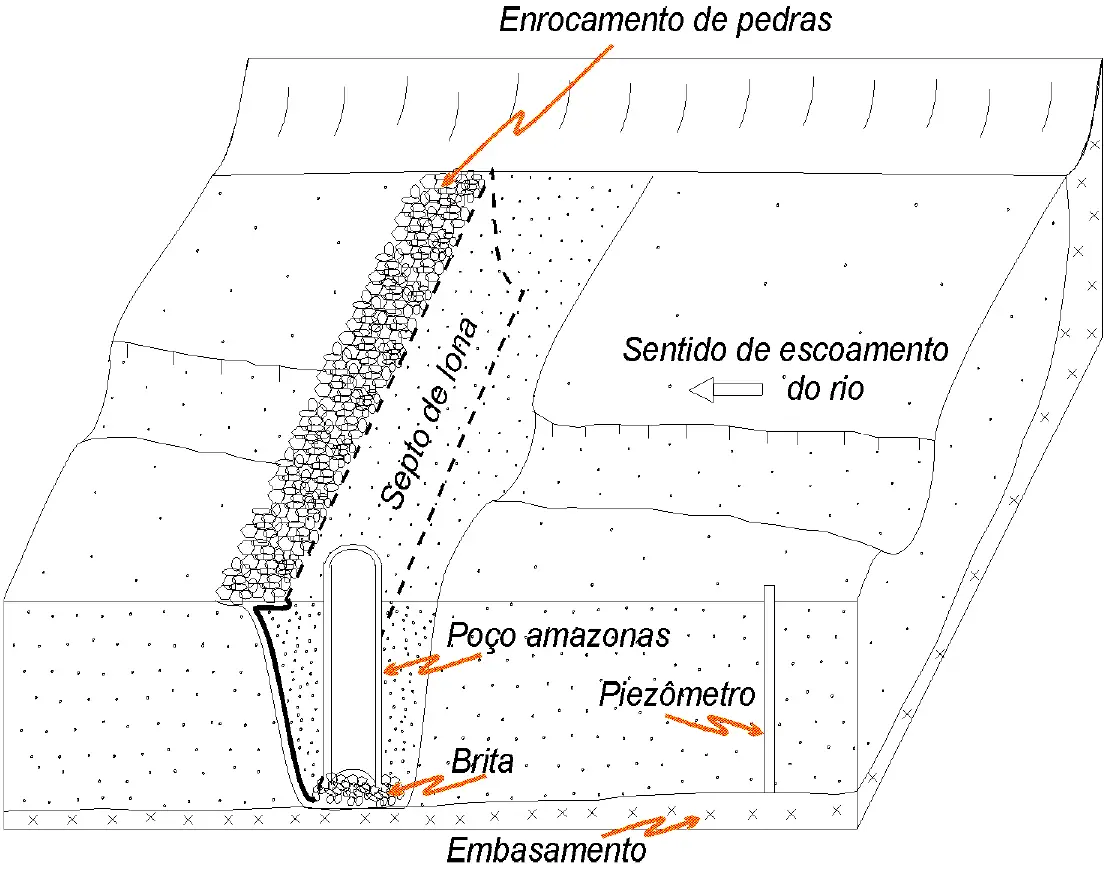
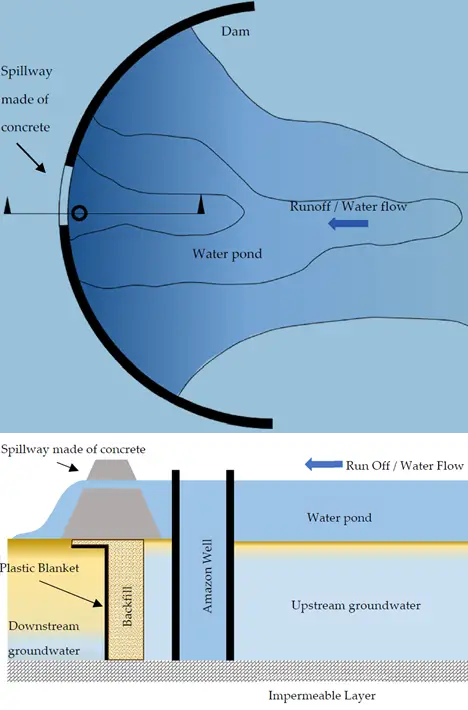
Next a more detailed, yet synthesised, description of the building steps of a Costa & Melo type underground dam is presented.
More detailed description of a Costa & Melo subsurface dam.
This text describes the basic concepts for the construction of the Costa & Melo dam, based on the work of Costa (2004).
This dam model was developed by researchers of the UFPE, Waldir D. Costa and Pedro G. de Melo, in the beginning of the 1980s, and further adapted to local conditions by the first researcher.
It consists of: (1) excavation of a straight trench normal to the stream direction; (2) location of an impermeable septum inside the trench; (3) building one or more large diameter well, one of them located besides the impermeable septum and containing drains along the trench; (4) surface rock filling, on surface, in the impermeable septum downgradient side; (5) implementing one or more piezometers upgradient the alluvium area influenced by the dam.
The main advantages are: (1) the execution is fast (1 to 2 days if machinery is used); (2) low construction costs; (3) may be built using local manpower; (4) allows monitoring the salinity and the water level; (5) may be used for multiple water usages.
The main disadvantage is that it requires local physical conditions already stated in the previous section.
One of the main issues to implement a subsurface dam is the social aspects and the water demand. It is crucial that the opportunities provided by constructing the dam are acknowledged by the local community and that its owner in committed to preserve and exploit it at the maximum of its water availability, mainly by growing the adequate crops.
Prior to the construction of the dam, and to find sites with the adequate conditions, some activities must be developed:
(1) Data survey: search needy local communities and, if this is the case, the conditions to grow irrigated cultures; climate data; hydrogeological reports; topographical and geological maps, areal-photo maps; (2) analysis of the data survey searching for the adequate physical conditions; (3) field survey, including water quality; (4) geological with or without geophysics profiling, in order to define the geometry of the alluvium bed and its granulometry; (5) if possible and justifiable, well drilling and pumping tests to define the hydraulic properties of the alluvium; and collecting water for chemical analysis; (6) project of the subsurface dam, considering: a) length of the dam, b) average depth of the trench, c) trench width, d) recommended septum type, e) type of large diameter well, f) number of needed wells, depending on the alluvium extension, g) number and location of the piezometers; (7) final conclusive report.
Costa (2004) goes through a thorough description of all the construction details of the underground dam. To get further information the reader is encouraged to read this reference (in Portuguese).
Just a remark, related to the pumping large diameter well, to be located in the deepest part of the alluvium upstream the dam: besides allowing a complete use of the groundwater, it gives conditions to deplete the aquifer during the period of the first annual rainfalls. This action renews stored water, thus avoiding salinization processes due to progressive evaporation.
Evidence of benefits from implementation
Advantages of Underground Dams
Some of the major advantages of these dams are, from a technical point of view [3]:
- The technology used behind these dams is very simple. In fact, aside community wells, these dams are the simplest and the most effective system for serving water needs of the poorer communities of Brazil.
- These dams are highly economical as they are built using locally available resources and technology.
- These dams are also easy to install, requiring no external expertise for operation and maintenance.
- In comparison to surface water reservoirs, these dams have very low evaporation rates.
- Being based on simple technology, they can easily be implemented along with other technologies like soil and water conservation techniques, and dug wells upstream.
From a social and agricultural point of view (Silva et al., 2021):
- Contribution to family’s food sovereignty and nutritional security;
- Increased access to and multiple uses of water;
- Diversification and integration, providing greater resilience and sustainability to family-based agroecosystems;
- Strengthening social inclusion and the productive organization of women and youth;
- Surplus is sold at local free markets;
- Creates a solidary space that is self-managed and farmer-led; and
- Is aligned with five of the 17 Sustainable Development Goals (SDGs) in the UN 2030 Agenda: 1, 2, 5, 6 and 13.
Disadvantages of Underground Dams
At times, installed dams leak or fail to provide good quality water, which proves that many vital issues are to be addressed before construction of these dams are carried out within a given alluvial valley on a large scale.
This may be overcome by the operating and adequate monitoring practices of the exploitation of the alluviums and their crops.
A general disadvantage of the construction of the subsurface dams may be baseflow reduction, thus affecting some groundwater dependent ecosystems.
Responsible entity
Since 2003 the implementation of subsurface dams in Northeast Brazil is supported by the Cisterns program – water for drinking and for agriculture (Programa Cisternas – água para beber e para agricultura) from the Ministry of Citizenship of Brazil [1] subsidizes the construction of subsurface dams for people living in rural areas and not having water supply or having limited access to water of good quality.

Institutional setting
Several entities have developed programs, acted and researched in the area of the subsurface dams:
ASA – Articulação Semiárido Brasileiro (Articulation of Brazilian SemiArid) a network that associates more than 3000 distinct organizations of civil society dedicated to defend, divulgate and put in action the political project of Semiarid coexistence.
EMBRAPA – Empresa Brasileira de Pesquisa Agropecuária (Brazilian Agricultural Research Corporation), from the Ministry of Agriculture, Livestock, and Food Supply, has been developing research since the 1980s, and has contributed to sharing the experiences of farmers, development agents and researchers, through the exchange of popular and technical-scientific knowledge.
CAATINGA – NGO that developed a type of subsurface dam and has been supporting local communities and constructing several dams.
IPT – Instituto de Pesquisas Tecnológicas de São Paulo (Institute for Technological Research), a public research institute linked to the Secretariat for Economic Development of the State of São Paulo, has developed studies and built subsurface dams in the Ceará and Rio Grande do Norte states.
SECTMA – Secretaria de Ciência, Tecnologia e Meio Ambiente (Secretary of Science, Technology and Environment) of Penambuco State, launched a program that promoted the construction of around 500 subsurface dams.
UFPE – Universidade Federal de Pernambuco (Federal University of Pernambuco) has developed the methodology and the technology to build the subsurface dams in Pernambuco state.
Geographical setting
The northeast Brazil semi-arid region covers an area of 1,108,435 km2 and includes 1348 municipalities distributed through nine states (Fig. 2). Precipitation is lower than 800 mm/year, the aridity index is lower than 0,50, evaporation is high, and the short period rainfall season presents irregular distribution [2].
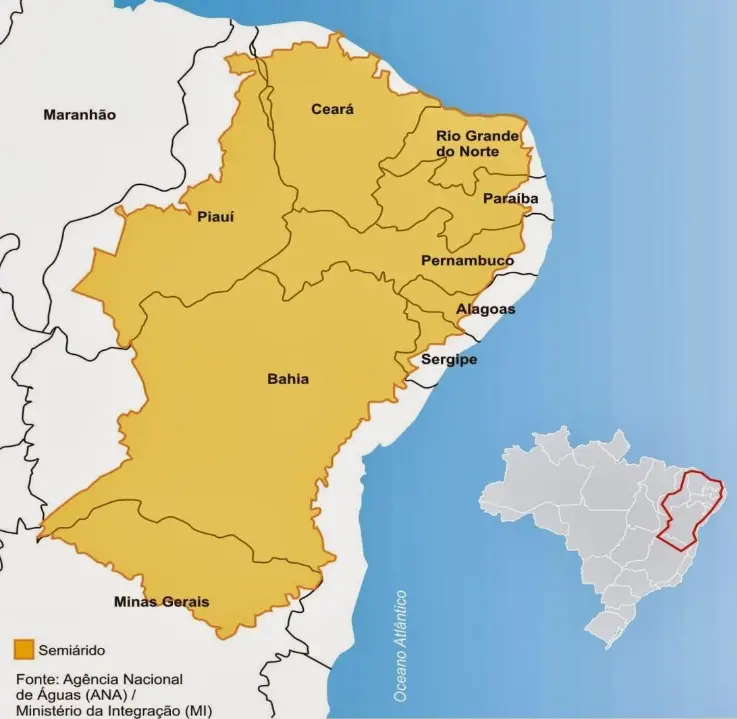
Fig. 3 represents some of the subsurface dams included in the IGRAC website.
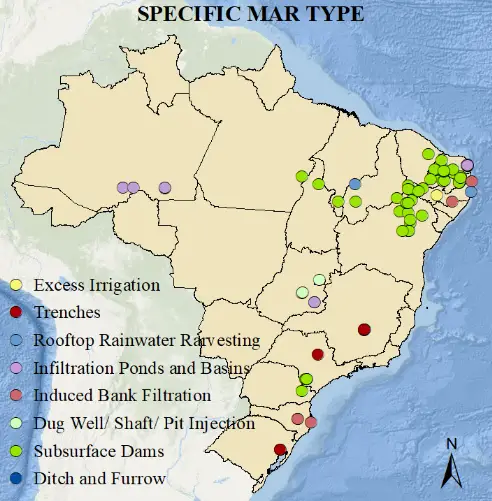
Historical overview
The present overview is based on Netto et al. (2007). The first historical records of subsurface dams go back to the Roman Imperium period, in Sardinia (Italy) and North Africa. Since the beginning of the 18th century, dams have been used mainly in north and southeast Africa, India, Israel and Iran. Also in Saara and, in the end of the 19th century, in California.
The first subsurface dam in Brazil dates back to 1919 in Paraíba semi-arid region, for agriculture development, and, also for the same purposes, in 1920 in Rio Grande do Norte semi-arid region. Other works have been put in place with more emphasis after 1935 in several semi-arid Brazilian states. Mainly the 1980s and 1990s were decades where a major implementation of these dams occurred to combat water scarcity and develop agriculture in local communities. This was accomplished with the help of NGOs, public institutes, universities.
For instance, in 1997, SECTMA has made experiments with the construction of six experimental units in Caruaru municipality (Pernambuco state). Due to the promising results, the Pernambuco state launched a program that promoted the construction of around 500 subsurface dams. UFPE, with the help of their students, followed-up the hydrology, hydrochemistry and socio-economic studies of some of these dams, namely those constructed in the Mutuca river in the Pernambuco state (Costa, 2004).
Since 2007 ASA has been implementing subsurface dams, and, through the program One land Two waters (P1+2), which is enclosed in the Cisterns Program, has built more than 1301 units, which benefited more than 5415 inhabitants. Fig. 6 shows the distribution per state accordingly with ASA (2018, in Silva et al., 2019).
Nowadays studies continue, and EMBRAPA and partners are developing an edaphoclimatic zoning project for potential areas for the construction of underground dams in the Alagoas Semiarid (ZonBarragem project). Based on the map generated as a result of the project, the Government of the State of Alagoas launched the State Program for Underground Dams (Silva et al., 2021).
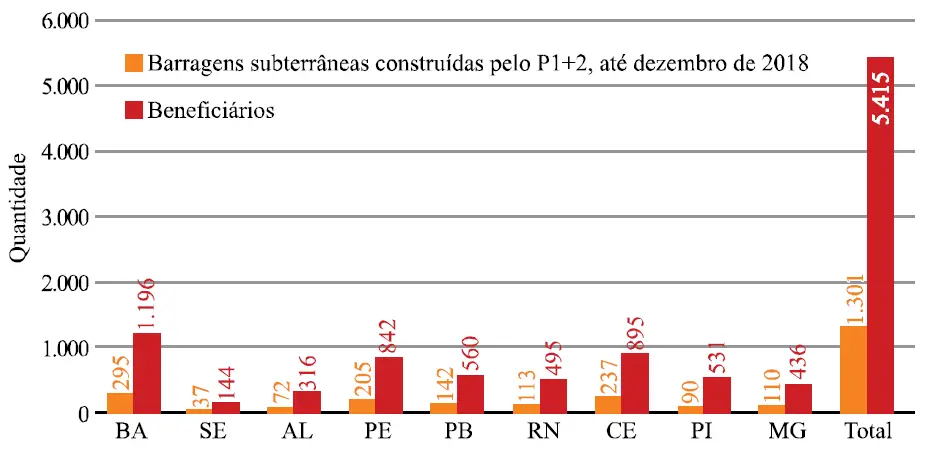
Replication potential in SUDOE region
Low precipitation and high evaporation areas in SUDOE region geologically composed of crystalline bedrock where alluviums develop are acceptable areas where small scale agriculture could be developed if underground dams were constructed. Especial attention should be paid for the general location conditions presented previously. The South Alentejo region in Southern Portugal could be a candidate region for the introduction of these technologies.
Future outlook
For small rural communities and maybe, in Europe, actual people movements willing to downshift their way of life, crop production in water enhanced small regions could become a desirable practice. Before implementing this kind of project, a general study concerning the water deficits that could be supplied using these infrastructures should be performed, confronting the crop types and the crop water demands.
In Alentejo region the underground dam solution may be boosted by the fact that under most of the climate change scenarios this region is expected to be more arid.
Key points of the innovative method
- These technology has been used with high success in several semi-arid regions of the world.
- It allows local communities development and their fixation in the countryside.
- The technology is low cost and easy to implement, using local manpower.
- Nevertheless it requires geological and socio-economic studies to define the adequate areas to be implemented.
- The operation of these areas requires formation of the owners for the best management of the farm areas (water exploitation, crop growing, monitoring water quality and groundwater level).
- The existence of a network of organisations facilitate the implementation of the programs to combat droughts and desertification.
Acknowledgements
This innovative practice was suggested by Prof. José Saldanha Matos from Technical University of Lisbon (IST-CERIS).
References
Cirilo, J.A.; Costa, W.D. (1999). Barragem subterrânea: experiência em Pernambuco. Proceedings of the 9th International Rainwater Catchment Systems Conference. Petrolina, Brazil.
Costa, W.D. (2004). Barragens subterrâneas: conceitos básicos, aspectos locacionais e construtivos. In Cabral, J.J.S.P.; Lobo Ferreira, J.P.C.; Montenegro, S.M.G.L.; Costa, W.D. (Organizadores): “Água Subterrânea: Aquíferos Costeiros e Aluviões, Vulnerabilidade e Aproveitamento”, pp. 223-276. 448 pp, Tópicos Especiais em Recursos Hídricos, Vol. 4., Recife, Editora Universitária UFPE, ISBN 85-7315-247-8., pp. 13-59
Netto, M.S.C.C; Costa, M.R.; Cabral, J.J.S.P (2007). Manejo integrado de água no semi-árido brasileiro. In: Cirilo,J.A.; Cabral, J.J.S.P.; Lobo Ferreira, J.P.C.; Oliveira, M.J.P.M.; Leitão, T.E.; Montenegro, S.M.G.L.; Góes,V.C. (Organizadores): O Uso Sustentável dos Recursos Hídricos em Regiões Semi-Áridas. Recife, Editora Universitária UFPE, ISBN 978-85-7315-451-1., pp. 473-501.
Shubo, T.; Fernandes, L.; Montenegro, S.G. (2020). An Overview of Managed Aquifer Recharge in Brazil. Water 2020, 12(4), 1072, 21 p. https://doi.org/10.3390/w12041072
Silva, M.S.L.; Lima, A.O.; Moreira, M.M; Ferreira, G.B.; Barbosa, A.G.; Melo, R.F.; Oliveira Neto, M.B. (2019). Barragem subterrânea. In: Ximenes, L.F.; Silva, M.S.L.; Brito, L.T.L. (Ed): Tecnologias de convivência com o Semiárido brasileiro. Fortaleza: Banco do Nordeste do Brasil. 2019. cap. 2. p. 223-281.
Silva, M.S.L; Marques, F.A.; Ribeiro, C.A.; Ferreira, G.B.; Melo, R.F.; Barbosa, A.G.; Lima, A.O.; Oliveira Neto, M.B; Rocha, W.J.S.; Parahyba, R.B.V.; Webber, D.C. (2021) – Underground dams: contributing to climate change resilience of family based agro-ecosystems in the semi-arid region of Northeastern Brazil. In: Sotta, E.D.; Sampai, F.G.; Marzall, K.; Silva, W.G. (Publishers): Adapting to climate change: Strategies for Brazilian agricultural and livestock systems. Brasília, Ministry of Agriculture, Livestock and Food Supply. 2021. p 88-89.
aquifer
NOTÍCIAS
Descubra mais sobre as notícias do projeto AQUIFER e sobre a gestão de aquíferos
NOTÍCIAS AQUIFER
Descrição e objectivos do projecto
The scientific community recommends a substantial improvement in the knowledge of aquifers, the establishment of reliable monitoring networks and a greater involvement of the administration and users to achieve a sustainable management of aquifers. The main objective...
Informação sobre o projecto
A Comunidade de Utilizadores de Água do Delta Llobregat concebeu bacias de recarga em Molins de Rei para recarregar o aquífero do Baix Llobregat. Vista de uma das bacias de recarga durante a fase de teste A Comunidade de Utilizadores de Água de Llobregat Delta é um...
Histórias de sucesso na gestão das águas subterrâneas
Compilação de histórias de sucesso na gestão das águas subterrâneas. Ao longo do mês de Abril, os 30 casos de práticas inovadoras na gestão das águas subterrâneas já foram seleccionados pelos agrupamentos que participam no projecto: PPA, CWP e AV. A tarefa começou com...
PROPONHA UMA
PRÁTICA INOVADORA
Está a desenvolver ou implementar uma prática inovadora em matéria de gestão de aquíferos e deseja referência-la na plataforma do projeto AQUIFER?
Preencha o formulário e faça uma proposta aos parceiros do projeto AQUIFER.
THE E-BOOK
O Aquífero oferece uma gama de práticas inovadoras de gestão da água. Pode descarregar todas as nossas fichas técnicas aqui.
E-BOOK DE PRÁTICAS INOVADORAS
DOCUMENTAÇÃO
Aprofunde a informação relacionada com a gestão dos aquíferos